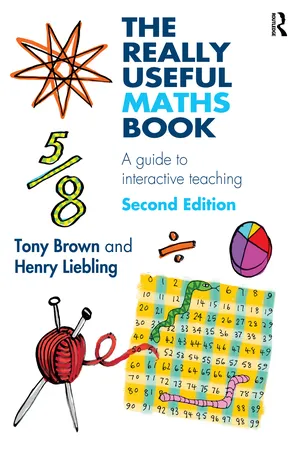
- 314 pages
- English
- ePUB (mobile friendly)
- Available on iOS & Android
About this book
The Really Useful Maths Book is for all those who want children to enjoy the challenge of learning mathematics. With suggestions about the best ways to use resources and equipment to support learning, it describes in detail how to make learning the easy option for children. An easy-to-follow, comprehensive guide packed with ideas and activities, it is the perfect tool to help teachers who wish to develop their teaching strategies.
The second edition has been fully updated in light of the latest research, as well as in response to the new mathematics curriculum. It includes many more practical activities for each mathematical topic and explores exciting new areas. Key topics covered include:
- Numbers and the number system
- Operations and calculations
- Shape and space
- Measures, statistics and data handling
- Cross-curricular approaches
- Resources and planning for teaching and learning
- Contexts for making sense of mathematics
- Bridges, strategies and personal qualities
- Dialogue and interactive teaching
- International perspectives on teaching and learning
- Psychology and neuroscience to maximize learning.
The Really Useful Maths Book makes mathematics meaningful, challenging and interesting. It will be invaluable to practicing primary teachers, subject specialists, maths co-ordinators, student teachers, mentors, tutors, home educators and others interested in mathematics education programmes.
Tony Brown was formerly the Director of ESCalate, the UK Centre for Education in HE at the Graduate School of Education, University of Bristol, UK.
Henry Liebling formerly led Primary Mathematics Education at University College Plymouth, Marjon, UK.
Frequently asked questions
- Essential is ideal for learners and professionals who enjoy exploring a wide range of subjects. Access the Essential Library with 800,000+ trusted titles and best-sellers across business, personal growth, and the humanities. Includes unlimited reading time and Standard Read Aloud voice.
- Complete: Perfect for advanced learners and researchers needing full, unrestricted access. Unlock 1.4M+ books across hundreds of subjects, including academic and specialized titles. The Complete Plan also includes advanced features like Premium Read Aloud and Research Assistant.
Please note we cannot support devices running on iOS 13 and Android 7 or earlier. Learn more about using the app.
Information
Part I
| PART I | MATHEMATICAL ACTIVITIES AND TEACHING STRATEGIES |
Part I: Introduction
WHAT IF NOT!–TURNING A SINGLE ACTIVITY INTO MANY

Starting points for planning
Some variables to think about when planning


Deciding how much direction to give
Investigate the number line between 0 and 1



Changing the order

Table of contents
- Cover Page
- Half Title Page
- Series Page
- Title Page
- Copyright Page
- Contents
- List of resource pages
- Acknowledgements
- Why another book about primary school mathematics?
- Using The Really Useful Maths Book
- Part I Mathematical Activities And Teaching Strategies
- Part II Developing Interactive Teaching Strategies
- Part III Additional Material